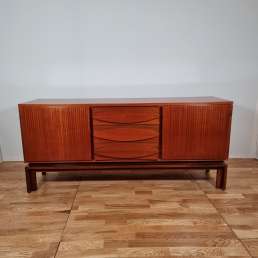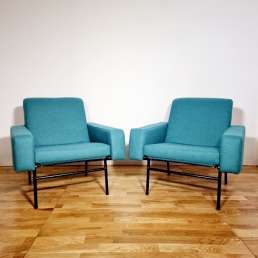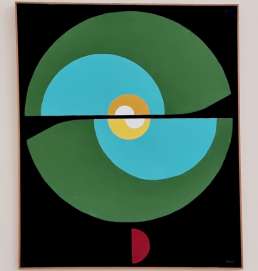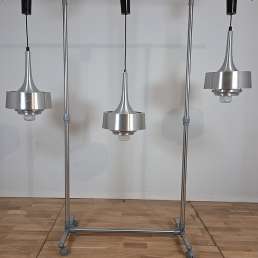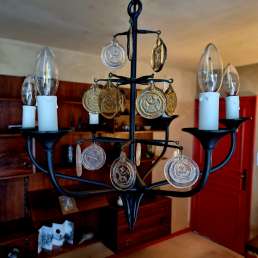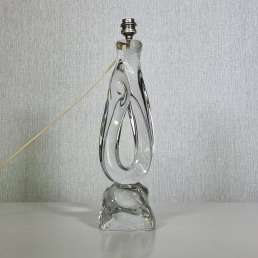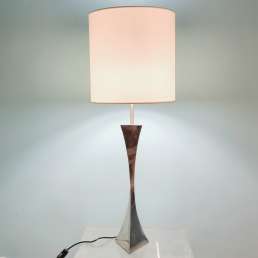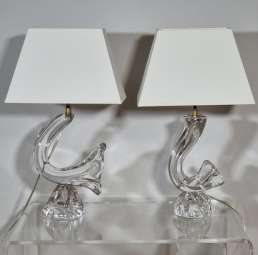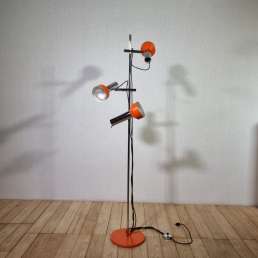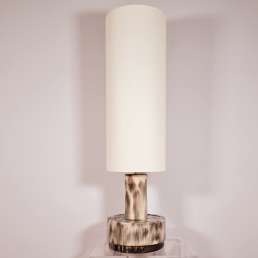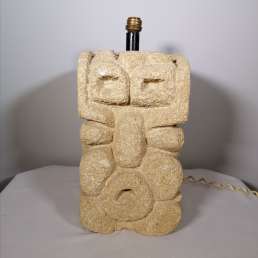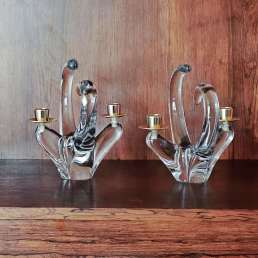Louis KALFF (1897-1976) for Philips, Pair of NX40 wall lights in wood, opaline glass, and lacquered metal, circa 1950
Description
What I like
What I like about these wall lights is their extremely simple line, combined with the beauty of just 3 materials: the veneer strip, the white lacquered metal and the cylindrical opaline glass diffuser are of biblical simplicity, of great accuracy: all that counts is the marvelous assembly making these wall lights a model of discretion and successful design.
I like the very Scandinavian side of this pair of wall lights, as well as their obvious insertion into the design of the 1950s and 1960s.
I like the fact that these wall lights were designed by the great luminist Louis Kalff: his collaboration with Philips gave rise to many lamps and wall lights, always extremely refined and elegant. This for a fairly large production: beauty entered many interiors!
Technical description
Louis KALFF (1897-1976) for PHILIPS
Pair of NX40 model wall lights, made up of a rectangular plate supporting an elbow tube receiving a black plastic bayonet socket and a circle of off-white lacquered metal, accommodating a white opaline tubular glass diffuser, a raised ring in the middle of this tube rests on the metal circle; a strip of thermoformed plywood and veneer wood, slightly wider in the center, fixed on the plate, hides the metal circle and the plate.
A small corner element allows the wall light to be fixed to the wall.
Two infinitesimal scratches on the glass.
Although unsigned, these sconces are referenced in multiple publications.
Dimensions and weight
Height: 40 cm – Width: 17 cm – Depth: 19 cm
Weight:1 kg each
Mix & Match
tex This pair of wall lights has infinite simplicity and elegance: the profile of the lampshade is reminiscent of Audrey Hepburn’s buns in films from the 1950s and 1960s. In addition, the veneer is warm. Their style and perfect size make them exist on the walls without attracting all the attention: but if you look at them more closely, you realize that they are perfectly designed and executed: great art.
As a result, they fit into many interiors: starting with those from the 1950s or 1960s: they will highlight the veneer and the lines of the “Oeils” sideboard by Joseph André Motte for the Hûchers, marry with our large armchairs with Streamline style lattice sides, with the refinement of their Canovas fabric embroidered by Lesage!
As with the productions of Pierre Guariche, in particular the G10 armchairs, in tonic blue or in the off-white curl of Bisson Bruneel! Their sobriety allows them to rub shoulders with more angular productions, like the Grass Hopper armchairs by Sonja Wasseur!
Finally, on the walls, they will illuminate the 1950/1951 Composition by Edgard Pillet, so colorful, but also the “Composition metallica” tapestry by Enrique Broglia, whose brown/black/gold range will echo that of the veneer!
Finally, on tables the grace of Daum lamp bases will show another way of achieving beauty, always at the cost of perfect technical mastery!
In stock
Description
To know more
The designer
Louis Christiaan Kalff (1897-1976) was a Dutch graphic designer, considered a pioneer of 20th century industrial design.
He quickly built up a varied artistic background, including object design, sculpture, ceramics and architecture, and began working for the household appliance company Philips in the advertising department in 1924. He quickly moved up the ranks. and becomes responsible. He will notably create the company logo.
In 1929 he created the Philips lighting design workshop and thus boosted the company’s sales. He would later become the artistic director of this company where he worked until his retirement in 1960.
During the 1930s, he was appointed head of the lighting department at the World Exhibition in Barcelona, Antwerp and Paris.
At the same time, he designed posters and advertisements as a freelancer for the seaside resort of Scheveningen in Holland, and for Radio Holland and also created some book covers.
Although he has worked for many agencies, he remains a freelance designer.
The editor
tex Fascinated by demonstrations of Thomas Edison’s first incandescent lamp in 1879, Gerard Philips (1858-1942) sought his father’s help to purchase a small plot of land in Eindhoven, the Netherlands, to establish his own light bulb factory. After a year, Anton, Gerard’s younger brother, joined the company as a salesman and helped the company grow into the largest carbon filament producer in Europe. In 1912, Philips signed a historic contract with Tsar Nicholas I, who ordered 50,000 light bulbs for his Winter Palace in Saint Petersburg. The same year, Philips entered Euronext, the Amsterdam stock exchange.
From the beginning, Philips was an export-oriented company, which aspired to establish itself in the rapidly growing electricity sector. In 1914, Philips launched its famous NatLab, a research center dedicated to the exploration of physics and chemistry to develop numerous product lines. Two years later, Philips celebrated its 25th anniversary and was granted the title of Koninklijke Philips Electronics (Royal Philips Electronics) by the Dutch monarchy.
Over the decades, Philips has produced a very wide range of products, such as medical x-ray tubes, radios, electric shavers, televisions, cassette and CD players, VHS and DVD players and many others.
A beautiful and authentic pair of wall lights at a fair price
This pair of wall lights has been carefully selected for its aesthetic qualities, its originality and its fair price. Our choice favors above all the acuity of the design, of which the signature of Louis Kalff is guarantor, as well as their manufacturing quality, attested by their distribution by Philips, guarantees of an enhancement of your new acquisition in your interior and of a ability to interact with your furniture, to match and mix to create a unique decoration.
Buying vintage wall lights is surely a reasonable investment, such is the appetite for the 1950s/1960s.
Finally, buying vintage wall lights preserves the resources of planet Earth.
Additional information
| Weight | 1 kg |
|---|---|
| Dimensions | 19 × 17 × 40 cm |














